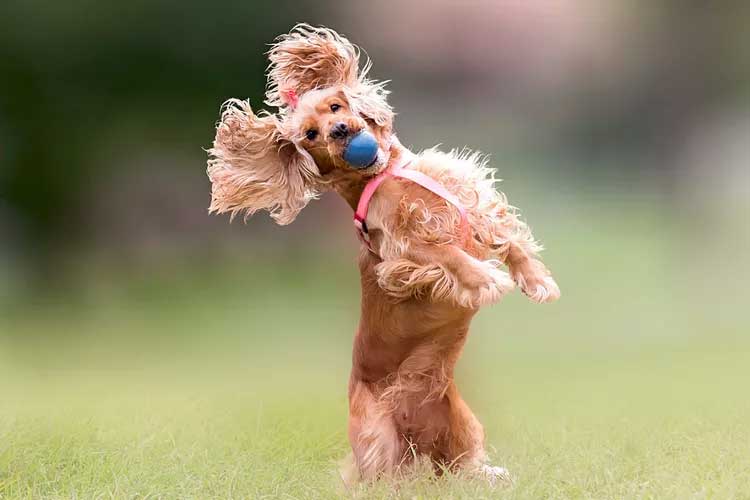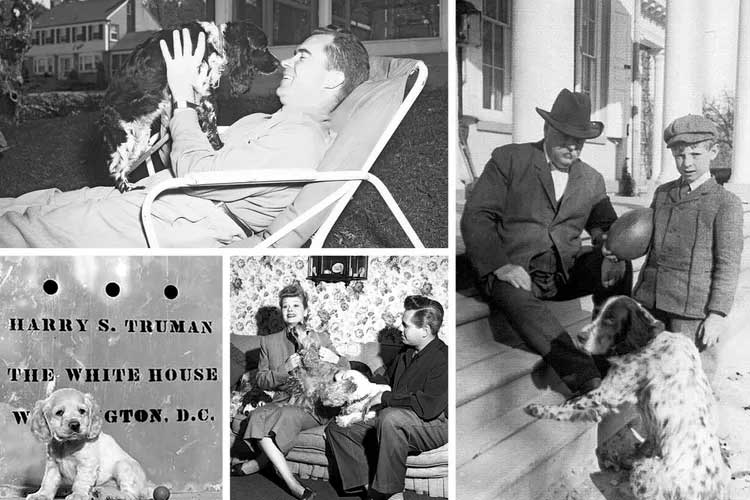Cocker spaniels are lively, sweet-natured, and beautiful—just the right size for many homes. A great option for families, cocker spaniels are highly trainable and affectionate. Read on to learn more about living with this beloved breed.

Cocker Spaniel Overview
| OFFICIAL NAME | Cocker Spaniel |
| COMMON NAME | Cocker Spaniel |
| PET HEIGHT | 14 to 15 inches |
| PET WEIGHT | 20 to 30 pounds |
| LIFESPAN | 10 to 15 years |
| GOOD WITH | cats, children, dogs, families, seniors |
| TEMPERAMENT | friendly, gentle, playful |
| INTELLIGENCE | high |
| SHEDDING AMOUNT | occasional |
| EXERCISE NEEDS | medium |
| ENERGY LEVEL | active |
| VOCAL LEVEL | frequent |
| DROOL AMOUNT | low |
| BREED GROUP | sporting |
| BREED SIZE | medium (26-60 lbs.) |
| COAT LENGTH | long, medium |
| COLORS | black, blue, brown / chocolate / liver, cream, gold / yellow, red, white |
| PATTERNS | bicolor, black and tan, flecked / ticked / speckled, merle, sable, tricolor |
| OTHER TRAITS | apartment-friendly, cold weather tolerant, easy to train, high potential for weight gain, high prey drive, loves water, prone to health issues, requires lots of grooming, strong loyalty tendencies |
Cocker spaniels are loving, easy-going, and affectionate—a treat to have as part of the family. They are generally smart and easy to train. Thanks to their relatively small size—they grow to about 14–15 inches tall and weigh no more than 30 pounds—they are also ideal for any size home, from apartment to single-family house.
Very loyal pets, they'll follow you from room to room all day long. Cockers also love going on brisk walks and seem to frolic everywhere they go. While they were originally bred as hunting dogs, they now make ideal companions for pet owners young and old.
Appearance
Cocker spaniels are moderately sized, beautiful dogs. Male pups stand 15 inches tall, and female dogs grow to 14 inches tall. They should not weigh more than 30 pounds—and will need your help in not overeating.
Cocker spaniels have thick, soft, wavy coats of many colors—black, light cream, red, white, and brown—and patterns, all with long, lush ears that people can't resist petting. The term "sweet puppy dog eyes" was likely inspired by cocker spaniels with their big, dreamy, pleading brown eyes. But their looks require constant attention, both at home and with visits to the groomer.
The cocker spaniel, also called the American cocker spaniel, is a distinctly different breed than the English cocker spaniel. Though both breeds have similar heritage, there are subtle differences: the cocker spaniel is longer than she is tall, whereas an English cocker spaniel is taller than she is long. The cocker spaniel also has a shorter muzzle than her English cousins, and her eyes are more almond-shaped.
Temperament
The cocker spaniel is a merry breed. They are also smart and trusting of their owners. While they do have a hunting instinct, they are happiest being a companion at home.They are up for whatever their owner wants to do, as they are happiest pleasing their human family. Care to snuggle up on the couch? A cocker spaniel is in. Kids want to run around in the yard? They are up for that, too. And while reserved initially, cocker spaniels make fast friends with most everyone they meet.

They have a sweet temperament and can be very affectionate and cuddly dogs. And with proper training, they also get along well with other pets, including cats. But thanks to their hunting instincts, sharing a home with a pet bird is not typically an option.
Living Needs
"Cocker spaniels are a beautiful dog with a very nice size, big enough to be sturdy and able to play with kids, but small enough to be an apartment or condo dog," says Ryan Steen, DVM, medical director at Frey Pet Hospital in Cedar Rapids, Iowa. As long as your cocker spaniel is raised with kids that are kind and respectful to animals, it's a match made in heaven.
People-oriented by nature, your cocker spaniel will prefer to be with you as much as possible. They enjoy being part of the family and truly thrive when they can be a part of all family activities. They do not do well when left alone and can turn to barking, crying, and other undesirable behaviors when anxious. If left outdoors, they will dig or bark to keep themselves busy.
While your cocker spaniel will certainly like to snuggle up on your lap, you'll need to make sure she gets plenty of exercise, too, thanks to her hunting heritage. While cocker spaniel puppies will be worn out on a short walk, adult cocker spaniels will need 30 minutes of walking twice a day with additional free time to play—they especially enjoy a good game of fetch. This exercise not only helps manage weight—cocker spaniels aren't one to turn down a snack—but also keeps your pup from getting grouchy.
Care
If you adopt a cocker spaniel, be aware that consistent grooming will be necessary, Steen says. Regular haircuts keep them looking their best and prevent their hair from matting.For a style that requires little maintenance, ask the groomer to trim your cocker spaniel's hair the same length all over, called a "puppy cut." Their trademark floppy ears are usually kept with longer hair no matter the style and need to be monitored for mats. Introduce your cocker spaniel to grooming early, because early introduction can make for more successful groomer visits. Be prepared to make regular grooming appointments—about every six to eight weeks—which can be an investment.
Between haircuts, plan to do plenty of brushing. Invest in a metal, professional-quality dog comb with fine and medium spacing for the teeth. If you encounter a tangle while brushing, pick through it gently. Regular baths—where you use a high-quality dog shampoo that you rinse thoroughly—are also essential. Nails should be trimmed regularly and you should wipe out their ears once a week to avoid infections.

Take steps to make sure their ears don't get soaked every time they go for a drink of water. Use deep, narrow bowls for food and water, or consider using a snood to protect her ears when your cocker spaniel eats.
Cocker spaniels make great therapy dogs, as they are gentle and very loving. They are a versatile breed and can be trained for agility courses as well—cocker spaniels are skilled at paying attention and following commands.
Training will require patience and repetition. Make sure to address barking early on. You'll spend considerable time on potty training as cocker spaniels are notorious for marking their spot indoors when excited or nervous. Lots of positive reinforcement over time will do the trick. Cockers are sensitive and don't respond well to harsh treatment, so be kind and gentle to bring out the best in their personality.
Health
Generally a healthy breed—typically living about 12–15 years—there are a few common conditions cocker spaniel owners should be aware of."Allergies and chronic ear infections are some of the most common ailments I see in cocker spaniels," Steen says. Their diet may be to blame, with common allergies to beef, chicken, corn, wheat, soy, milk, and eggs. Check with your veterinarian for suggestions on changes to their diet.
And ensure you aren't overfeeding your pooch. They will overeat and use their big, brown eyes to convince you they need a second helping at feeding time. But an overweight cocker is an unhealthy cocker.
As they get older, cocker spaniels are prone to heart, liver, or kidney failure, as well as cancer. Cocker spaniels are also sometimes affected by epilepsy, progressive retinal atrophy (which causes blindness), and cataracts (which requires expensive surgical correction).
History
The cocker spaniel originated in Spain and has been mentioned as far back as the 14th century. By the 1800s, they were divided into two groups: toys (for companionship) and hunting dogs. Named for their excellence in field hunting the woodcock, they were recognized as an official breed in England in 1892. Cocker spaniels are thought to have been brought to North America with the pilgrims. In fact, the American Spaniel Club was created in 1881 and is the oldest breed club in America.
Cocker spaniels quickly became popular dogs both with pet owners and breeders, and they did particularly well in the show ring. In 1921, a cocker spaniel took home Westminster Kennel Club's Best in Show for the first time. In 1946, the American Kennel Club recognized the American cocker spaniel and the English cocker spaniel as two distinct breeds.
Fun Facts
Cocker spaniels were one of the first nine breeds recognized by the AKC.Cocker spaniels are the smallest member of the sporting dog category.
Brucie, a black cocker spaniel, also helped popularize the showy breed by winning Westminster's Best in Show back to back in 1940 and 1941.
Cocker spaniel popularity in the U.S. significantly increased when the breed was featured in Disney's Lady and the Tramp in 1955.
Media mogul Oprah Winfrey owns two cocker spaniels, Sophie and Solomon.
Breeding a cocker spaniel with a poodle produces the intelligent, loving cockapoo.